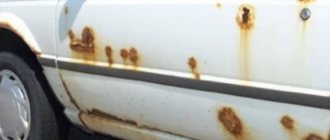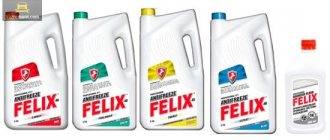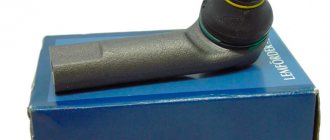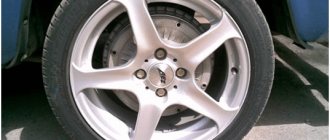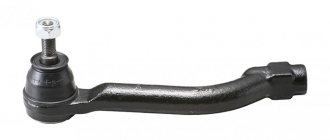Every car owner wants his car to serve him faithfully for many years. One of the main obstacles on this path is corrosion - the most terrible enemy of all metal products. Well, the most “metallic” part of the car is the body, which means that the main blow of corrosion will be directed against it.
Accordingly, automakers are trying to slow down this process by resorting to various body treatment methods, one of which is hot-dip galvanizing. Cars with hot-dip galvanized bodies, a list and rating of the most corrosion-protected cars - below.
Full or partial processing
Corrosion is the main and very dangerous enemy of metal. First, a barely noticeable yellow coating on the parts, then swelling of the paintwork and, finally, obvious rotting of the body panels, all this occurs due to aggressive and constant exposure to water, dirt, and sand. Temperature changes, mechanical damage and chemical reagents that are sprinkled on public roads make their negative contribution.
To prevent this problem, the body is specially protected from rust at the production stage by covering it with a layer of zinc. But the vast majority of modern cars undergo only medium or minimal processing. From such partial protection, although it successfully protects the part at first, nothing remains after 2-3 years of operation. The dealers themselves recommend that on such machines, additional treatment of panels against rust, especially hidden cavities, niches, seams, and bottoms, is carried out.
A fully galvanized car body is not subject to corrosion for a long time - almost 30 years. It all depends on the type of galvanizing (this will be discussed in detail below) and the operating conditions of the car.
Cold galvanizing
The last method is cold galvanizing. This method is similar to the previous one in technology, but this one is even simpler and cheaper. Some car owners can process body parts using this method in their garages. The car does not need to be immersed in a special zinc-containing solution for this. The solution itself is applied to the body using an electrode, which is connected to the positive terminal (the car body is connected to the negative terminal). Some car repair shops offer a service for processing car body parts, but complete processing cannot be done this way. Since this method is not used by car manufacturers, it is not worth describing it in detail.
Methods for galvanizing a car body
In mechanical engineering, there are several types of galvanization of the car body. Let's look at each of them in detail.
Hot (thermal) method
The classic and best type of treatment involves lowering a dry body into a bath of molten zinc. The temperature in the container can vary between 500-4000 degrees Celsius. The manufacturer provides a guarantee of 15 years or more for car bodies treated in this way.
Full immersion in hot zinc makes the metal panels incredibly resistant to corrosion and last forever. Even damaged areas of the body, chips and cracks, self-heal over time - they are covered with a thin layer of zinc deposits. And in general, this thermal method, although more expensive, provides a protective layer thickness of 2-15 microns.
Initially, this type of galvanizing was used in German. The first galvanized car was the Audi A80. Further, this method was adopted by Volvo, Porsche and other automakers. Today, despite the high cost of the technology, hot-dip galvanizing is carried out not only on the bodies of luxury cars. Place foreign cars Chevrolet (Corvette model) and Ford (Explorer, Focus, Fiesta and Mustang) in a hot bath with zinc.
Of course, this method is widely used by auto industry giants:
- Audi is a pioneer in the field of body heat treatment and a world leader in this field. Cars of the German brand rarely need to be repaired due to external damage, except after serious accidents. The Ingolstadt manufacturer makes full use of hot-dip galvanizing technology - it carries out partial, complete or combined processing. For example, on A4 models, individual body parts are placed in molten zinc. And the bodies of models such as the Q5 are completely immersed in the bath.
- This Stuttgart brand always tries to keep up with the best. Full and partial zinc treatment of the body is one of the ways to stand out among competitors. The first car from the manufacturer to receive a fully galvanized body was the Porsche 911. This happened in 1989. The body of the 911 Carrera modification was partially subjected to one-sided hot-dip galvanization. Since 1999, the same version has been completely processed using stainless steel.
- Swedish Volvo. Like Audi, it galvanizes almost all of its models. A popular method is double-sided hot processing or immersion of the core in the melt.
Of course, such galvanized cars are an order of magnitude higher than their analogues. However, taking into account the costs of body restoration, their price is fully recouped during operation. Isn’t it true that if a car lasts more than 15 years without repair, you won’t mind spending any money on buying it?
Condition of the Audi 100 body after 23 years of operation!
Galvanic processing method
This is already bathing in a bath with zinc-containing electrolyte. Stainless steel is deposited on the surface of the metal due to the action of electricity, and not high temperature. The method, which was adopted in order to save money, is now actively used by most automakers.
The galvanic treatment procedure looks something like this:
- the body itself or its panels are immersed in a container filled with an acidic zinc solution;
- The negative terminal from 220 V is also connected here;
- The container is connected to the positive - electrolysis begins.
The galvanizing method makes the car less resistant to rust, but ensures almost perfect uniformity of the protective coating. The result is an incredibly beautiful, smooth and shiny body. The thickness of the protective layer during galvanic treatment is 5-20 microns. The manufacturer's warranty does not exceed 10 years.
Since galvanic treatment provides comparatively worse protection against corrosion, some manufacturers thicken the layer to 9-25 microns, use high-alloy steel and add a durable primer layer.
Well-known brands that use galvanic processing:
- Chevrolet;
- Skoda;
- Toyota - almost all models;
- Mitsubishi.
The famous German giants are also fans of the galvanic method: BMW, Mercedes-Benz, Volkswagen. They use special steel and apply an impressive layer of expensive paint, thereby protecting the body almost as well as Audi with its heat treatment.
Cold galvanizing
The cheapest way to protect iron from corrosion. In recent years, it has become widespread among budget car brands. Treatment in this case is nothing more than spraying or painting metal panels with primer containing highly dispersed zinc powder. In the finished protective coating, the zinc content does not exceed 90-93%.
This method of body processing has been adopted by Chinese and some Korean manufacturers. They often use stripped-down galvanization, when the back side of the body panel is simply primed and painted. This allows you to save a lot, and the cars remain fresh for a long time. The rotting process remains invisible, as it occurs on the reverse sides of the parts.
Body parts that rot most quickly
Content:
- 1 Types of galvanization
- 2 Hot-dip galvanized vehicles
- 3 Galvanized models
- 4 Domestic equipment
Galvanization of elements acts as a panacea for such problems. It allows you to protect your car from an impressive list of damages. Let's figure out what it is, how it works, and who uses it.
Cars with galvanized bodies: complete list
For a list of cars with galvanized bodies, see the table below.
Russian-made cars undergoing galvanization
The bodies of AvtoVAZ models are subjected to partial cold galvanizing or cold galvanizing of node connections. Lada Priora of the latest modifications is coated with zinc better than anyone else - 80-90%. On the Lada Vesta only the sills are left untreated, on the Xray the roof is left untreated. The second generation Lada Kalina is painted with stainless steel everywhere except the hood, roof and side members. The Lada Granta is galvanized to a minimum - only the wings and doors.
Until 2014, UAZ Hunter, Pickup, Patriot, 23602-cargo were partially galvanized by cold galvanizing, just like Vases. But since 2014, they began to use full galvanic double-sided galvanization with a protective layer of 9-15 microns.
UAZ Patriot weak points
Since 2009, cars produced by GAZ (Gazel, Sobol, Siber) have been processed by partial cold galvanizing. The same method is used to protect the bodies of all modifications of Gazel Next. The remaining models on the market today are cold galvanized at their node connections.
List of cars that can last up to 30 years without corrosion
We have prepared a rating of cars whose owners need not be afraid of corrosion.
Audi A6 C4
The model was produced from 1994 to 1997. Thus, the “youngest” Audi A6 C4 is now 24 years old. Despite this, cars are still actively sold on the secondary market, and one of the main reasons for this is the almost “eternal” body, completely hot-dip galvanized.
New Audi A6 C4
A major overhaul of the engine, suspension, and brake system may be required, but nothing will happen to the body parts.
Ford Focus
The model has been produced from 1998 to the present. Perhaps the only representative of budget cars on the list treated with hot-dip galvanizing. It is extremely popular in the secondary market; many cars of the first generations are still “on the move”.
These achievements would not have been possible without the full hot-dip galvanization that Ford generously bestows on its vehicles.
Porsche Cayenne 955
The model was produced from 2002 to 2010. A premium crossover with permanent all-wheel drive, excellent interior trim, powerful engines and a body that will never rot.
How to find out if a car has undergone anti-corrosion zinc treatment
Information about this can be found in the technical documentation for the vehicle. If you couldn’t find the word “zinc” in the papers, the body is unlikely to be protected from corrosion in any way.
To determine the presence of galvanized car body without papers, you will have to spend a lot of money. In particular, seek a service from a specialized center or trust the information provided on the Internet.
Partial protection or its complete absence can be judged by the cost of the car. Budget models are rarely galvanized, especially using one of the high-quality methods. They are simply treated with inexpensive paints and materials. These cars include Asian economy class cars.
Galvanic galvanizing
Galvanic galvanization can be used for complete body processing, as well as for individual elements. This is a simpler technology for protecting vulnerable areas of the body. The underbody of the car, sills and arches are often galvanized - the places most vulnerable to corrosion. Partial anti-corrosion treatment is used for inexpensive cars that are sold in large quantities.
Table: cars with galvanized body
| Audi 100 C3 1986, 1987, 1988 | Partial hot-dip galvanized (one-sided) |
| Audi 100 C4 1988-1994 (all modifications) | Partial hot-dip galvanized (one-sided) |
| Audi A1 8x 2010-2019 | Full hot-dip galvanized (double-sided) |
| Audi A5 8t 2007-2016 and 2 2016-2019 | Full hot-dip galvanized (double-sided) |
| Audi Allroad C5 2000 | Partial hot-dip galvanized (one-sided) |
| Audi Allroad C5 2001-2005 | Full hot-dip galvanized (double-sided) |
| Audi Q3 8u 2011-2019 | Full hot-dip galvanized (double-sided) |
| Audi R8 (all modifications) | Full hot-dip galvanized (double-sided) |
| Audi Rs-6 (all modifications) | Full hot-dip galvanized (double-sided) |
| Audi S2 | Partial hot-dip galvanized (one-sided) |
| Audi S6 C4 and C5 | Partial hot-dip galvanized (one-sided) |
| Audi S6 C6 and C7 | Full hot-dip galvanized (double-sided) |
| Audi Tt 8n | Partial hot-dip galvanized (one-sided) |
| Audi Tt 8j and 8s | Full hot-dip galvanized (double-sided) |
| Audi A2 8z 1999-2000 | Partial hot-dip galvanized (one-sided) |
| Audi A2 8z 2001-2005 | Full hot-dip galvanized (double-sided) |
| Audi A6 (all modifications) | Full hot-dip galvanized (double-sided) |
| Audi Cabriolet B4 | Partial hot-dip galvanized (one-sided) |
| Audi Q5 | Full hot-dip galvanized (double-sided) |
| Audi Rs-3 | Full hot-dip galvanized (double-sided) |
| Audi Rs-7 | Full hot-dip galvanized (double-sided) |
| Audi S3 8l | Partial hot-dip galvanized (one-sided) |
| Audi S3 8v | Full hot-dip galvanized (double-sided) |
| Audi S7 | Full hot-dip galvanized (double-sided) |
| Audi 80 B3 and B4 | Partial hot-dip galvanized (one-sided) |
| Audi A3 8l | Partial hot-dip galvanized (one-sided) |
| Audi A3 8p, 8pa, 8v | Full hot-dip galvanized (double-sided) |
| Audi A7 | Full hot-dip galvanized (double-sided) |
| Audi Coupe 89 | Partial hot-dip galvanized (one-sided) |
| Audi Q7 | Full hot-dip galvanized (double-sided) |
| Audi Rs-4, Rs-5 | Full hot-dip galvanized (double-sided) |
| Audi Rs-q3 | Full hot-dip galvanized (double-sided) |
| Audi S4 C4 and B5 | Partial hot-dip galvanized (one-sided) |
| Audi S4 B6, B7 and B8 | Full hot-dip galvanized (double-sided) |
| Audi S8 D2 | Partial hot-dip galvanized (one-sided) |
| Audi S8 D3, D4 | Full hot-dip galvanized (double-sided) |
| Audi 90 | Partial hot-dip galvanized (one-sided) |
| Audi A4 | Full hot-dip galvanized (double-sided) |
| Audi A8 | Full hot-dip galvanized (double-sided) |
| Audi Q8 | Full hot-dip galvanized (double-sided) |
| Audi Quattro after 1986 | Partial hot-dip galvanized (one-sided) |
| Audi S1, S5, Sq5 | Full hot-dip galvanized (double-sided) |
| BMW 1, 2, 3 E90 and F30, 4, 5 E60 and G30, 6 after 2003, 7 after 1998, M3 after 2000, M4, M5 after 1998, M6 after 2004, X1, X3, X5, X6 , Z3 after 1998, Z4, M2, X2, X4 | Fully galvanized (double-sided) |
| BMW 8, Z1, Z8 | Partial galvanization (double-sided) |
| Chevrolet Astro after 1989, Cruze 1, Impala 7 and 8, Niva 2002-2008, Suburban Gmt400 and 800, Avalanche pre-styling | Partial galvanization (double-sided) |
| Chevrolet Captiva, Cruze J300 and 3, Impala 9 and 10, Niva 2009-2019, Suburban Gmt900, Avalanche post-restyling | Fully galvanized (double-sided) |
| Chevrolet Aveo, Epica, Lacetti, Orlando, Blazer 5, Cobalt, Evanda, Lanos, Camaro 5 and 6, Spark, Trail-blazer | Fully galvanized (double-sided) |
| Chevrolet Blazer 4, Camaro 4 | Partial galvanization (double-sided) |
| Chevrolet Corvette C4 and C5 | Partial hot-dip galvanized (one-sided) |
| Chevrolet Corvette C6 and C7 | Full hot-dip galvanized (double-sided) |
| Fiat 500, 600, Doblo, Ducato, Scudo, Siena after 2000, Stilo | Partial galvanization (double-sided) |
| Fiat Brava and Bravo until 1999, Tipo 1995 | Cold galvanizing of node connections |
| Ford Explorer, Focus, Fiesta, Mustang, Transit after 2001, Fusion, Kuga | Full hot-dip galvanized (double-sided) |
| Ford Escort, Scorpio, Sierra | Partial hot-dip galvanized (one-sided) |
| Honda Accord, Civic, Cr-v, Fit, Stepwgn, Odyssey after 2005 | Fully galvanized (double-sided) |
| Hyundai Accent, Elantra, Getz, Grandeur, Santa-fe, Solaris, Sonata, Terracan, Tucson after 2005 | Partial cold galvanizing |
| Hyundai Galloper | Cold galvanizing of node connections |
| Infiniti Qx30, Q30, Q40 | Fully galvanized (double-sided) |
| Infiniti M-series until 2006 | Partial cold galvanizing |
| Jaguar F-type Coupe, Roadster | Full hot-dip galvanized (double-sided) |
| Jaguar S-type after 2007, Xe, E-pace | Fully galvanized (double-sided) |
| Land Rover Defender, Freelander, Range-rover after 2007 | Fully galvanized (double-sided) |
| Mazda 5, 6, Cx-7 after 2006, Cx-5, Cx-8 | Fully galvanized (double-sided) |
| Mercedes-Benz A-class, C-class, E-class, Vito, Sprinter minibus after 1998, B-class, M-class, X-class, Gls-class | Fully galvanized (double-sided) |
| Mitsubishi Galant, L200, Lancer, Montero, Pajero since 2000, Asx, Outlander | Fully galvanized (double-sided) |
| Nissan Almera since 2012, March, Navara, X-trail since 2007, Juke | Fully galvanized (double-sided) |
| Opel Astra, Corsa, Vectra, Zafira since 2008 | Fully galvanized (double-sided) |
| Porsche 911 since 1999, Cayenne, 918, Carrera-gt | Full hot-dip galvanized (double-sided) |
| Porsche 959 | Partial galvanization (double-sided) |
| Renault Megane, Scenic, Duster, Kangoo | Partial zinc metal |
| Renault Logan | Fully galvanized (double-sided) |
| Seat Altea, Alhambra, Leon, Mii | Fully galvanized (double-sided) |
| Skoda Octavia since 1999, Fabia, Yeti, Rapid | Fully galvanized (double-sided) |
| Toyota Camry since 2001, Corolla since 1991, Hilux and Land-cruiser since 2000 | Fully galvanized (double-sided) |
| Volkswagen Amarok, Golf, Jetta, Tiguan, Polo, Touareg | Fully galvanized (double-sided) |
| Volvo C30, V40, V60, V70, V90, S90, Xc60 | Full hot-dip galvanized (double-sided) |
| Lada Kalina, Priora, VAZ-2111, 2112, 2113, 2114, 2115 since 2009, Granta, Largus | Partial cold galvanizing |
| Vaz-Oka, 2104, 2105, 2106, 2107, 2108, 2109, 2110 since 1999 | Cold galvanizing of node connections |
If you have any questions, leave them in the comments below the article. We or our visitors will be happy to answer them
Let's sum it up
Now we know which cars have a galvanized body. The lists are gradually increasing as manufacturers are able to use proven and inexpensive methods, for example, adding zinc to primer or paint. Therefore, you need to take into account some nuances highlighted by auto experts:
- Reliable protection of the vehicle body by galvanizing is possible only with expensive models, since investing in budget options is considered unwise - they simply will not pay for themselves.
- In the modern world, the level of body preparation is much worse than it was 10-20 years ago. While cars produced in the 1990s were built to last for decades, today this period has been reduced to 7 years, after which the car can be scrapped. Therefore, you should not believe dealers who claim that the service life of any new model is at least 10 years, because its body is galvanized - this is a marketing ploy, nothing more.
- In the technical specifications, any manufacturer may indicate that the machine is galvanized, although in fact it is not. At least this applies to the already mentioned budget models, when only some body elements were subjected to this procedure.
Cooling radiator
Troubles are also possible with him. They can be caused by three reasons:
- The most harmless option: wait until it cools down, the traffic jam is over - and you drive on with a light heart;
- the core is clogged inside with refrigerant deposits or dust. The pressure through the radiator drops, cooling is insufficient;
- scale and deposits in the pipes. The thermal conductivity of the hoses decreases, and the liquid does not have time to cool again.
Except the first option
Water pump:
It most often fails in those machines where torque is supplied to the pump pulley separately from the gas distributor. The pulley rotation speed may decrease if the drive belt is loose (stretched). After making sure that your thermostat is normal, try tightening the belt and driving after the engine has cooled and topped up the coolant.
Fan:
If the fan is killed, this is the easiest reason to determine. Even if the car does not have a corresponding sensor warning that the fan is not working, a person who is not behind the wheel for the first time will hear it by sound. In the city and slowly, with a non-working fan, you can get to a repairman. Outside the city, we are looking for a tug.
Is it possible to do galvanizing at home and what is required for this?
Galvanizing a car body with your own hands is quite possible, but it does not imply complete, but partial coating of certain elements with a protective layer. These may be areas that are most susceptible to corrosion: fender liners, sills, areas under the feet of the driver and passengers, door cards, as well as places where the paintwork is damaged.
The home method of applying zinc protection is something between cold and galvanic galvanization. But more on that a little later. And now about what is required for this.
Required tools and tools:
- latex gloves;
- zinc chloride or sulfate (soldering acid);
- a piece of zinc;
- glass vessel;
- car battery or charger;
- a piece of clean rag (gauze);
- sandpaper;
- degreaser (solvent);
- baking soda solution.
If you do not have the opportunity to purchase a ready-made zinc salt solution, you can prepare it yourself. To do this, take sulfuric or perchloric acid and dissolve pieces of zinc in it in a ratio of 1:0.4, i.e. for one liter of acid – 400 g. metal
This is done as follows. Pour acid into a glass container (glass, jar) and immerse zinc in doses until they stop interacting. The reaction occurs in the form of dissolution of the metal with the release of hydrogen. Therefore, be extremely careful: work with gloves and away from open heat sources. When the reaction stops, the solution can be considered ready. Filter it and drain the precipitate. Now you can begin the actual process.
